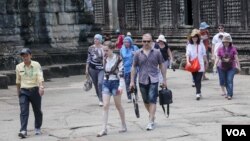Walking under the bright sun toward the centuries-old monuments of Angkor, a professional-looking man in an orange shirt leads a group of Taiwanese tourists.
Yim Chanphal, a licensed tour guide, embarked on this career in late 2006. Phal’s job mainly consists of showing groups of tourists around the temples of Siem Reap and elaborating to the visitors the meanings of ancient sculptures and carvings. He spent more than nine years learning Mandarin Chinese, a skill he uses frequently with his mostly Chinese clients.
Phal makes $25 a day for this work, but only gets paid if he is chosen to lead a group.
In 2010, he got $20 per day, he told VOA Khmer, meaning his basic pay has changed little in the past five years or so.
Other Cambodians who work as tour guides, a profession that requires strong language, communication and organization skills, also say their incomes have remained largely flat at a time when the cost of everyday essentials has been rising.That is despite a huge rise in Cambodia’s takings from the tourism industry.
According to the Ministry of Tourism’s annual report for 2015, the annual revenue from tourism last year was $3 billion, almost double the $1.7 billion taken in 2010.
“It has not changed much for me,” Phal said. “However, it is enough for me to support my family. Before, when I was single, I didn’t have to spend as much, but now I have my wife and my children, I have to earn extra. But my wage is enough to support them.”
Additionally, Phal’s customers often choose to tip him, and he can make an extra $20 to $30 per tour group.
“It depends on how charitably minded the customer is and the size of the group,” he added. “I think it is suitable because we do not have a fixed salary. Only when there are more customers can we find more income.”
Ho Vandy, general secretary of the Cambodia National Tourism Alliance, said tour guides’ incomes were dependent on their experience, how many days they work and the level of hospitality they provide for the tourists.
“First, it depends on their ability. Second, it depends on their style of work. Third, is their care for the customers,” he said.
Driven largely by rising visitor numbers to the Angkor Archaeological Park, the sector has become the country’s biggest earner after garment exports. In June, Cambodia was awarded the “World Best Tourist Destination for 2016” by the European Council on Tourism and Trade.
For those at the front line of this industry, the tour guides, incomes are highly seasonal. During the busy months from the middle of November to mid-April, guides can earn up to $1,000 per month; during low season they might have no work for months at a time.
Hay Sokha, a tour guide who performs similar duties to Phal for French-speaking tourists, said he enjoys a slightly higher income of $40 per day.
But he also said the wage level had not risen much since he began working in 2013, although it is higher than the $30 a day that guides were getting in 2010.
“Our country does not have direct flights. Before customers come to Cambodia, they spend all of their money in Thailand or Vietnam before they even reach us. They also rarely buy souvenirs,” Sokha told VOA Khmer, adding that the money he gets from tips is actually decreasing, while daily expenses are rising.
“I have to spend on electricity, water and housing. In a month, we have to spend at least around $500,” he said. “I think we [tour guides] should get more than this.”







